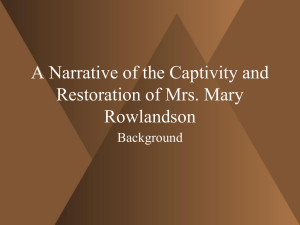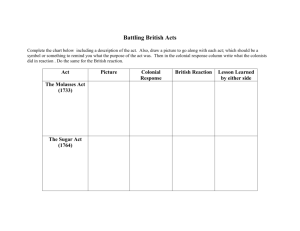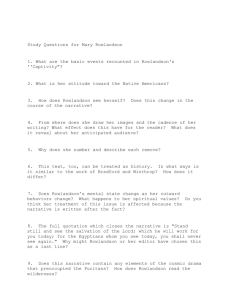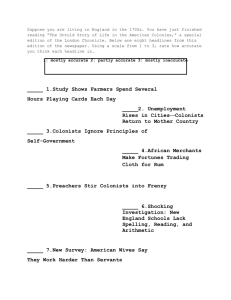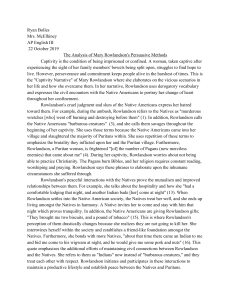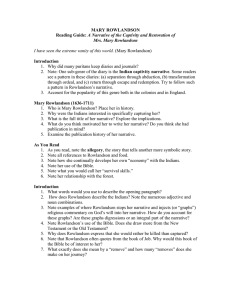Becoming Americans: English colonists and Native culture
advertisement
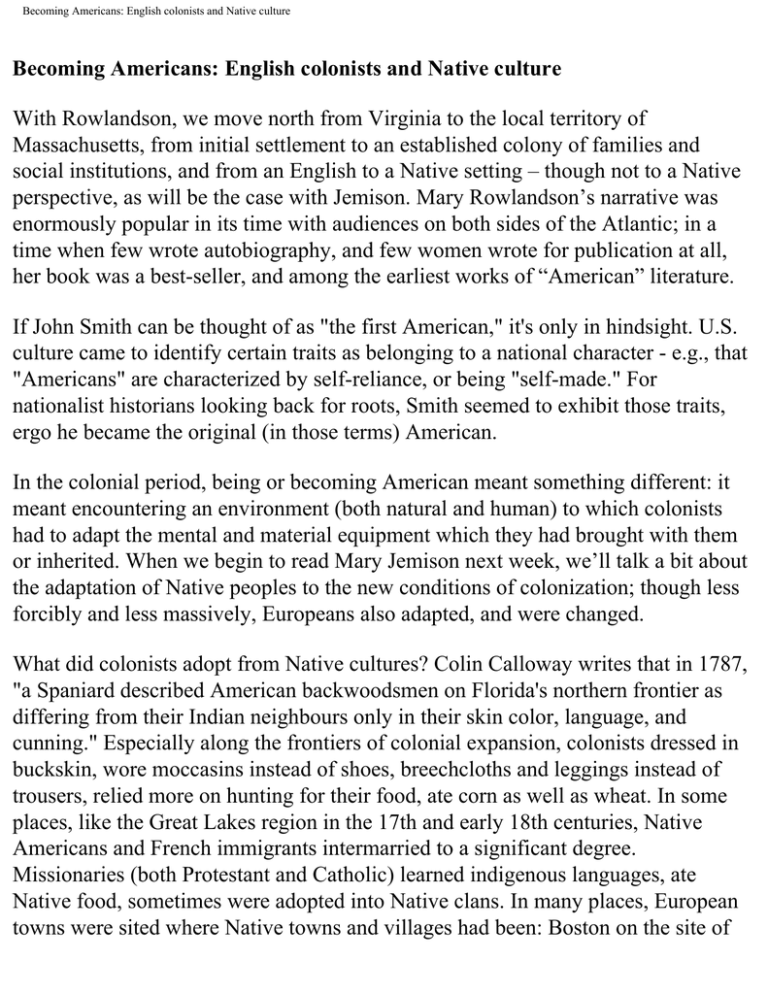
Becoming Americans: English colonists and Native culture Becoming Americans: English colonists and Native culture With Rowlandson, we move north from Virginia to the local territory of Massachusetts, from initial settlement to an established colony of families and social institutions, and from an English to a Native setting – though not to a Native perspective, as will be the case with Jemison. Mary Rowlandson’s narrative was enormously popular in its time with audiences on both sides of the Atlantic; in a time when few wrote autobiography, and few women wrote for publication at all, her book was a best-seller, and among the earliest works of “American” literature. If John Smith can be thought of as "the first American," it's only in hindsight. U.S. culture came to identify certain traits as belonging to a national character - e.g., that "Americans" are characterized by self-reliance, or being "self-made." For nationalist historians looking back for roots, Smith seemed to exhibit those traits, ergo he became the original (in those terms) American. In the colonial period, being or becoming American meant something different: it meant encountering an environment (both natural and human) to which colonists had to adapt the mental and material equipment which they had brought with them or inherited. When we begin to read Mary Jemison next week, we’ll talk a bit about the adaptation of Native peoples to the new conditions of colonization; though less forcibly and less massively, Europeans also adapted, and were changed. What did colonists adopt from Native cultures? Colin Calloway writes that in 1787, "a Spaniard described American backwoodsmen on Florida's northern frontier as differing from their Indian neighbours only in their skin color, language, and cunning." Especially along the frontiers of colonial expansion, colonists dressed in buckskin, wore moccasins instead of shoes, breechcloths and leggings instead of trousers, relied more on hunting for their food, ate corn as well as wheat. In some places, like the Great Lakes region in the 17th and early 18th centuries, Native Americans and French immigrants intermarried to a significant degree. Missionaries (both Protestant and Catholic) learned indigenous languages, ate Native food, sometimes were adopted into Native clans. In many places, European towns were sited where Native towns and villages had been: Boston on the site of Becoming Americans: English colonists and Native culture Shawmut, Ipswich on the site of Agawam, Northhampton on the site of Norrwotuck. The landscape was transformed - by grazing, felling trees for timber and to clear fields, and by new plants which came with the colonists - but colonists also adapted the Native use of controlled fires to burn back underbrush. European appetites for fur transformed Native economies and hunting practices in the process of putting beaver hats on the heads of fashionable folks, but the fur trade operated primarily by means of canoes, which like snowshoes and toboggans were an efficient technology adapted from Native cultures. Native people adopted European guns for hunting and war, but developed different tactics for their use; Europeans, in turn, ended by adopting Native ways of using their own weapons. (Source: Colin Calloway, New Worlds for All (Baltimore: Johns Hopkins, 1997). Native people came to be dependent on some European trade goods, alcohol being perhaps the most damaging. The European side of the encounter was not without its dependencies as well, tobacco being among the foremost - King James I of England was already publishing broadsides against tobacco use in the early 1600's. English appetites for colonial sugar (much of it imported from plantations in the West Indies) exploded in the 18th century, once the taste for drinking sweetened tea spread to the middle and lower classes; between 1650 and 1800 consumption increased by 2500%. Old world dietary habits were irreversibly changed by the importation of (especially) potatoes and corn - both became crucial sources of calories for people from Ireland, to West Africa, to Eastern Europe and beyond, and increased population densities stimulated emigration. In Ireland, the potato blight of the nineteenth century devastated a population which had become reliant on it as its primary food. In the late 17th century, large processes of both adaptation and exploitation were already underway. Reading Mary Rowlandson Rowlandson’s narrative is set in what is now Massachusetts during the interethnic violence of King Philip's War (1675-76), a "war of resistance" mounted by the Wampanoag and their allies against the encroaching settlers of the New England colonies. "One of the bloodiest conflicts in American history," King Philip's War drew in the Mohawks as English allies, and the Maine Abenakis on the other side; the non-combatant Narragansetts of Rhode Island were overrun by Puritan armies Becoming Americans: English colonists and Native culture for harboring refugees. King Philip, or Metacomet, would eventually be caught and killed, as was Weetamoo or Wittimore, a female sachem whom Rowlandson dislikes – both figure in her narrative; their surviving family members were probably sent to the West Indies colonies as slaves. Against this background of internecine violence, we read that Rowlandson was taken captive by Wampanoags who burned her house and killed friends and family before her eyes. Over and above her own cultural prejudices, Rowlandson had no reason to love her captors, and she did not. Yet her narrative not only offers us an account of life on the Wampanoag side of the conflict, albeit from a hostile point of view; despite Rowlandson's anger and fear, it is also a story of adaptation, exchange, and cultural compromise.
